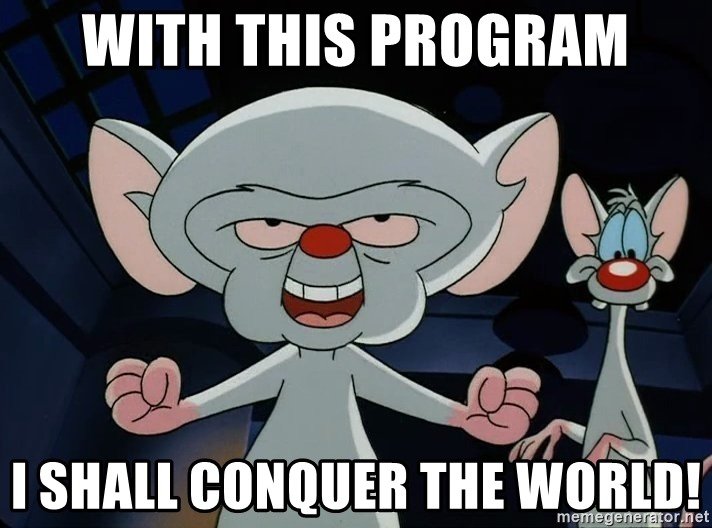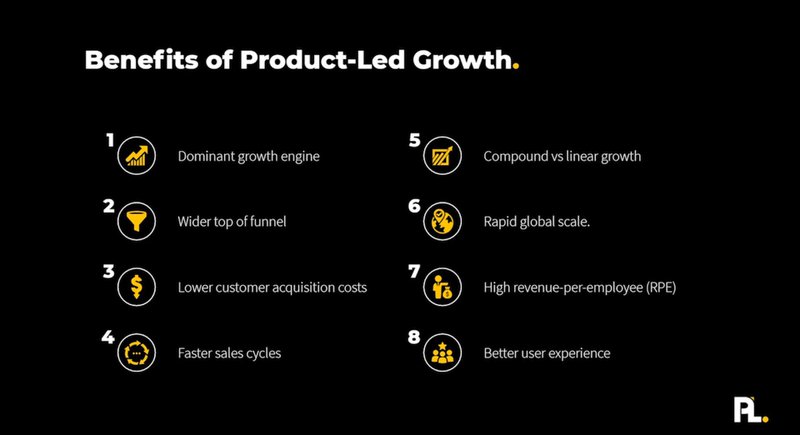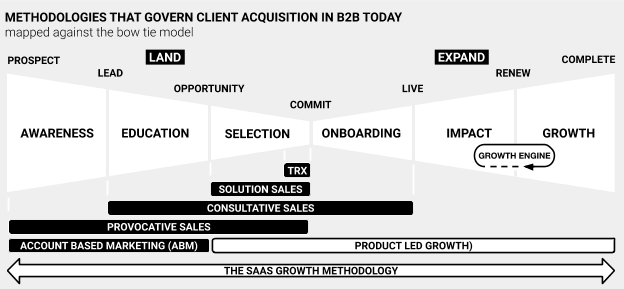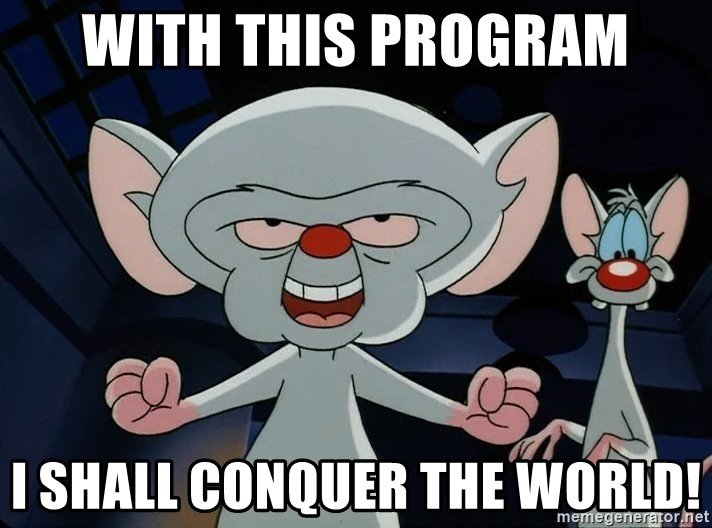As an early-stage venture capitalist, I speak with a lot of founders that are in the process of finding product-market fit. They are building the first version of a kick-ass product with which they can conquer the world… or at least their market.
To disrupt a market, you indeed need to build a damn good product. But it doesn't stop there: building the product is step one, getting people to use it is step two. To grow your SaaS company, you need both a great product and a great growth process.
(If you’re short on time: skip to the tl;dr at the bottom)

Recently, I see more and more founders adopting a product-led growth strategy to grow their business. The core idea of product-led growth is that your product is the main growth engine to acquire, activate and retain customers. In fact, Product-Led Growth has become so popular that it can now be capitalized and abbreviated (PLG). Heck, you can even get Product-Led Growth Certified now!
Introduction to Product-Led Growth
The way people buy products – specifically software products – has changed massively over the last years. Whereas software is traditionally sold via on-premise, perpetual licenses, the SaaS market grew from ~$30 to ~$157 billion in the last six years (yet still only accounts for 23% of the total software market 🤯).
An important aspect of PLG is "try before you buy", which in software comes down to a freemium model or offering a free trial. According to Wes Bush (Founder and CEO of ProductLed), 3 out of 4 potential B2B buyers like to try before they buy. Freemium model and free trials allow them to do just that. By offering either of these, you can catch potential buyers earlier on in their buying journey (when they are still researching, but not ready for a demo yet). This will also help in widening the top of your funnel, which will help you grow your SaaS company.
A dominant growth engine and a wider top of funnel are not the only benefits of PLG. To name a few benefits: adopting a product-led strategy has the potential to lower your CAC, shorten sales cycles and ultimately get to a high revenue per employee. Ultimately these benefits lead to a faster growth and/or a higher profitability. PLG experts OpenView Partners calculate that publicly traded PLG companies trade at a 50% premium compared to non-PLG SaaS companies.

It's no surprise that a lot of Silicon Valley's tech darlings helped shape the PLG movement. Companies like Slack, Dropbox, Notion or Zoom grew through a PLG approach before it was called PLG. Remember the Great Dropbox Space Race, where you could earn extra storage space for referring friends?
More recently, Zoom managed to grow from 10M to 200M DAU in the three months after the pandemic outbreak, thanks to product-led growth. Most users – team Peak included ✌ – went from free to paid team licenses, without any demo's or sales process. We simply upgraded our free individual accounts to a paid team account overnight. The PLG Certification course estimates that Zoom would have needed 131,944 sales reps if all new users would have required a demo. Talk about efficiency!
But… it's not just about product, you also need distribution to grow your SaaS company
I mentioned in the intro: building a product is step one, getting it to users is step two. Building a great product without any users is the tech industry's equivalent of "If a tree falls in the forest and no one hears it, does it make a sound?".
Or, as various successful founders can attest: the best product doesn't always win, and distribution is key to grow your (SaaS) company:
While you need a great product to become a great business, a great product by itself is not always enough. In my opinion, PLG is a great growth engine for companies that have an intrinsic sharing mechanism. Slack is only fun when you invite your team mates. Zoom is useless if you don’t have anyone else to talk to. Notion gets better as you collaborate on your pages. However, this sharing mechanism is unfortunately not prevalent in every SaaS company, especially in B2B.
Introducing Process-Led Growth
When your product does not organically pulls in customers, you will have to reel them in yourself. And that's where process-led growth comes in (unfortunately the PLG abbrev is already taken). Attracting early customers requires a growth process, which can be broken down into the following parts:
1. Clearly identify your customer and their need
You probably (hopefully!) started building your product to solve a certain problem. Perhaps you wanted to make it easier for companies to aggregate all your customer contact channels in a single inbox (Trengo), or maybe you wanted to make it more fun to meet online with colleagues and friends at a time when physical meetings weren't possible (Mibo) (shameless plug 😉).
Contacting your customers from a single inbox (Trengo) is relevant for most companies, nowadays, but which companies may benefit most from such a solution? To grow your business consistently, you should have a clear idea of your ideal customer profile (ICP) and segment across axes such as:
- Needs based: try splitting up your TAM into segments of customers that need your product for the same reason. Some companies might need a contract lifecycle management tool to manage sales contracts, while others may use the same solution for their HR contracts. Cater these segments to their specific needs
- Company size: SME’s deal with very different problems than large corporates with thousands of employees
- Industry: your product will most likely have better adoption in some sectors than others. I don't know many dentist offices that use Slack, yet I also don't know many tech companies that don't.
- Geography: most early stage companies start scaling in their home country first. Perhaps your product will generate traction faster in other countries. Our German portfolio company GraphCMS actually sees most traction with Nordic and US customers.
- Tech stack: integrate your product with other SaaS products that your ideal customer already uses. It's easier to sell a contract lifecycle management solution to legal teams that are already using CRM systems than to luddite lawyers that still have a Rolodex on their desk (shudder 😖)
2. Estimate your customer’s willingness to pay:
Now that you have defined your ICP, you want to figure out how much they are willing to pay for your product. In my experience, willingness to pay strongly correlates with a) the size of the problem that your solution is solving and b) the degree to which that problem is core to your client’s operations. In other words: if you can build an effective solution for your client’s mission-critical problems, you will be able to command a good price. This ties in with the vitamin-painkiller distinction.
Another thing to take into consideration: watch out for the dead zone. Do not price your product around the $10k ACV mark. As this article explains very well, this price point requires quite some sales effort while it’s too low to pay for a sales team.
3. Understand your customer's buying process:
Once you know which companies will buy you product, and how much they are willing to pay, you will want to figure out how their buying decision making works. The buying decision depends a lot on the type of company. In SME's you might have to deal with a company owner calling the shots, whereas large corporates may have procurement committees / departments with pre-allocated budgets. Who is/are the key decision maker(s) within the company? Is the decision maker the same person as the end user?
There are various frameworks to help you suss out your customer's process. Have a look at the BANT (budget, authority, need, timing) or the Miller Heiman Blue Sheet.
4. Map out your growth funnel…:
One of the reasons why we like SaaS, marketplace and platform companies here at Peak, is because everything is measurable. Use this to your advantage to grow your SaaS company. Make sure that you map out your growth funnel, from first marketing touchpoint to closed customer. In the early days this process will be hard to define, and every customer might look like a different case. But as you continue talking to customers, you will likely discover a pattern in their buying behavior and the process it requires to close them.

5. …and make it measurable:
Once you have mapped out your funnel, try to measure as many steps as along the way as possible. This starts with properly using a CRM system and getting everyone on the team to consistently use it (which sounds easier than it is). As you grow, try to get as close as possible to tracking the funnel end-to-end, from first marketing touchpoint to upsell. This, again, sounds easier than it is, as it usually requires tying together various data sources.
6. Identify channels that work, and double down on them:
The main reason for mapping out and measuring throughout your growth funnel, is to see what works. It's great if your top level KPI's are growing, but if you have no idea where the growth comes from, then you can’t repeat or scale it. As investors we are always on the lookout for companies that have found a channel (or more) that works and that can scale. Perhaps it's user generated content, perhaps it's whitepapers. Maybe it's review sites such as G2 or forums like Quora. It might even be plain old paid ads. Oh, and don't forget TikTok.
7. Identify customer success and steer your customers towards it (if necessary):
Most products have a so-called "Aha moment". It's the first moment when the user realizes the true value of your product. For Facebook this was getting to 7 friends in 10 days. From thereon, most users started seeing the value of interacting with their friends through the platform.
Identifying the Aha moment is key to a well-onboarded user, and ultimately to healthy customer retention (which, together with scalable marketing and sales channels, is one of the most important metrics we look at at Peak).
A Product-Led Growth approach can be very helpful in customer onboarding. Some products (such as Facebook) are very self-explanatory, and users will have no issue getting to the “Aha moment” themselves. For many enterprise-focused products, however, this is a bit more nuanced. Products such as a GraphQL-first Headless CMS or an AI-powered end-to-end customer feedback platform require some more handholding and customer onboarding. If your customers need a gentle push to get to their “Aha moment”, make sure to help them.
The amount of onboarding that you provide should align with the value you are getting out of that customer. If your customer is paying you $50 in recurring revenue per month, you can't spend too much manual attention on every new customer. In these cases you want to make sure that customer onboarding is fully done by and within the product. For enterprise solutions with ACVs in the tens or hundreds of thousands, you can invest more in onboarding the customer. And if you’re somewhere in between? Well… get out of the dead zone.
TL;DR
Adopting a product-led approach has many potential benefits to grow your SaaS company. This is especially true if you are building a product that has an intrinsic viral component.
However, B2B SaaS companies do not always have such a component, especially in the early days. In this case: don’t forget about process-led growth either. Finding your ideal customer, understanding your funnel and defining customer success are crucial steps to onboard and retain customers.
Looking for more resources on how to grow your SaaS company? Check out these articles from my colleagues:
- How to assess your SaaS product strategy – insights from a Unicorn veteran
- 7 strategies for pricing and packaging for your SaaS product
- Not SaaS-specific, but relevant!: The Virality Handbook for Founders
- 8 learnings on ‘the war for talent’ from Peak’s Founder Sessions
Looking for an investor or exit partner?
Get in touch with us! No warm intro needed 😉
For your convenience, I also attached the form below. You’re busy building a company – and we don’t want to keep you hanging. Using this form helps us to streamline our process and get back to you as quickly as possible. We look forward to knowing more about your big idea and the team making it a reality!
